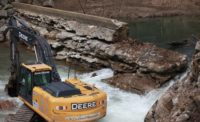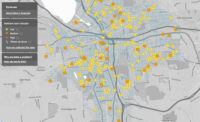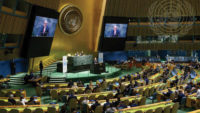The U.S. Army Corps of Engineers needs to change its approach to flood risk projects amid climate change-fueled sea level rise and more frequent intense weather events, environmental advocates say.
In a Nov. 10 letter to Michael Connor, newly confirmed assistant Army secretary for civil works, the Environmental Defense Fund and dozens of other groups ask Corps officials to “improve and evolve” strategies for addressing current and future flood risks tied to climate change.
“More people are at risk from flooding than ever before, and that risk is growing rapidly as climate change fuels more intense hurricanes and rainfall, and as sea level rise threatens coastal communities across the country,” the groups wrote.
A spokesperson for Connor said the Corps will consider issues raised in the letter. The Corps already is addressing some climate change risks through programs such as Engineering With Nature.
“Stakeholder input will continue to be very important as the nation addresses its current and future flood risks,” the spokesperson said.
The groups say the Corps should consider holistic approaches to address flood risks, alleging that the current strategy focuses just on hurricane storm surge and is shortsighted related to rising sea levels. The advocates say the Corps should “fully incorporate the impacts and solutions to independent and compounding flooding” in all coastal risk management studies, expanding their parameters to include sea level rise and extreme storms along coastal and river floodplains.
The groups also say the Corps needs to prioritize “natural solutions” as opposed to such structural ones as barriers, levees and gates, since those don’t mitigate flood risk from tidal flooding, sea level rise and precipitation. So-called “gray infrastructure” can have negative impacts, such as restricting animals’ movement, altering tidal flow or habitat degradation, according to the groups' letter.
Conversely, they say nature-based features can offer protection against storms, pointing to a 2008 study that estimated U.S. coastal wetlands provided $23.2 billion per year in storm protection benefits. There are other benefits that a Corps cost analysis may overlook, such as habitat diversity, improved water quality, carbon sequestration and even recreation and tourism.
“In our rapidly climate-changing world, the standard flood risk reduction operating procedures of the previous century no longer suffice,” said Natalie Snider, associate EDF vice president of climate resilient coasts and watersheds, in a statement.
The Corps has already started looking at nature-based flood risk management, releasing in September in its Engineering With Nature initiative, the 1,000-page “International Guidelines on Natural and Nature-Based Features for Flood Risk Management.” It highlights use of natural features along coasts such as beaches and dunes, coastal wetlands, islands, reefs and aquatic vegetation, as well as river, floodplain and wetland restoration and other nature-based solutions for fluvial systems.
In October, the Corps released its Climate Adaptation and Resilience Plan as part of the Biden administration goal of confronting the climate crisis. The plan calls for the agency to take actions such as modernizing its programs to support climate-resilient investments and using information on projected climate-related changes when planning work.
The Corps has faced criticism over these issues before.
When its New York District released a draft report following 2012's Superstorm Sandy on a plan for a $119-billion sea wall with gates from Queens to New Jersey, some officials criticized it as only addressing storm surge that would be insufficient to protect New York City from rising sea levels. In Texas, where the Corps has proposed a $28.87-billion plan with barriers and gates along the Gulf Coast, local experts have said additional defenses such as in-bay island barriers made of dredge material are needed as well.
EDF and the other groups say current Corps approaches to flood risks also don’t consider systemic inequities. Low-income communities and those of color are at greater flood risk and have more difficulty recovering from flood events. their letter states. The groups want the Corps to consider social costs and modify its cost-benefit analysis and decision-making processes to address equity, or to even waive benefit-cost ratio requirements for underserved communities to avoid bias in property values.
“The economic, environmental and social costs of ignoring the multiple flood threats impacting our coastal and riverine communities is astronomical,” the letter states. “We need to act now to take more holistic, equitable and long-term approaches to meet the very real and severe threats of a changing climate.”






